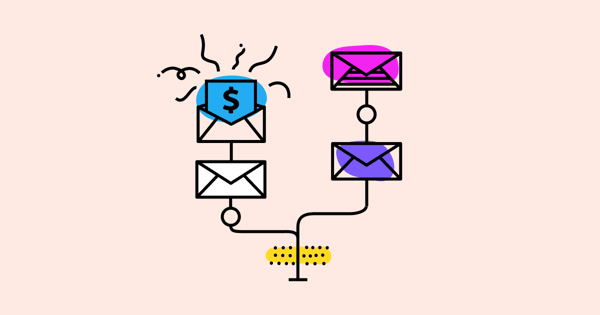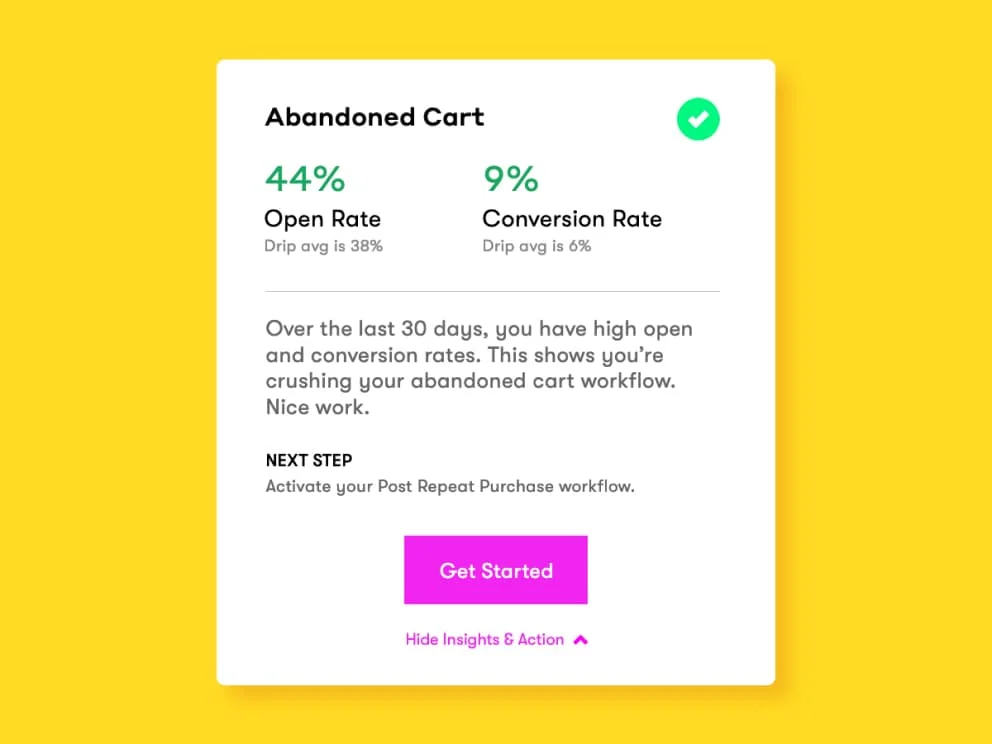Not getting the results you want for your ecommerce store from your email campaigns?
Before you cover your standing desk with all the hair you’ve torn out while looking at your analytics, you should consider implementing automated email workflows.
Work smarter, not harder. Yes, it’s a cliché. But email workflows are the simplest way to send personalized emails at scale. Be smart about it and you’ll boost revenue.
Here you’ll learn about the most effective email workflows and the strategies that make them so powerful, as well as how to create email workflows for your ecommerce store from scratch.

Ecommerce Email Workflows 101
What Is Email Automation?
Automated emails are sent to customers automatically using email marketing software. They allow you to send personalized and timely messages to consumers.
Automated emails are usually part of a sequence that’s based on behavioral triggers. These are called workflows. And these workflows are optimized to have the biggest impact based on the actions of the consumer.
What Are The Benefits of Automated Email Workflows for ecommerce store owners?
1. Better Engagement
One-size-fits-all messages just get ignored. Today’s consumers expect to see emails that are tailored to their interests.
People are also more likely to engage with emails that are relevant to them. Thus, triggered messages have a 65.7 percent higher open rate and 7.5 percent higher clickthrough rates than business as usual emails.
2. Increase Revenue
You can use automated email campaigns to build customer relationships, win back disengaged customers, encourage them to return to their carts, etc. So it’s no surprise that automated emails generate 8x more opens and clicks than other emails and can generate 6x more revenue.
3. More Leads in Less Time
Admittedly, it’s going to take some time to understand customers and their behaviors. And to set up carefully-considered workflows.
But once that’s done, you can sit back and watch the leads roll in. It’s the only way to send personalized emails at scale.
Marketers cite saving time and lead generation as the top two benefits of email marketing automation.
5 Ecommerce Email Workflow Examples You Need to Know
There are five particular email workflows that every ecommerce store needs. Here, we’ll break down why these sequences are so important, what they need to contain, and how to create great email content for each sequence.
Let’s go:
1. Email Welcome Series
The welcome series is one of the most important email workflows as it may be the first email contact between your store and the customer. So you need to make a strong first impression.
Use the welcome series to introduce your brand and get potential customers excited about what you have to offer.
In this welcome email, Ghetto Gastro shares its brand values through its tagline and imagery:
 This is a powerful expression of what the brand stands for. It invites customers that share these values to get involved with the brand.
This is a powerful expression of what the brand stands for. It invites customers that share these values to get involved with the brand.
The email also goes on to explain what newbies can expect from their subscription:
 Subscribers won’t regret signing up because of all the perceived privileges they’ll receive. By sharing these incentives, the customer will even specifically look out for emails from Ghetto Gastro in the future.
Subscribers won’t regret signing up because of all the perceived privileges they’ll receive. By sharing these incentives, the customer will even specifically look out for emails from Ghetto Gastro in the future.
This is just email number one, though. Overall, your welcome series may look something like this:
- Email 1. Introduce your brand
- Email 2. Give a behind-the-scenes look
- Email 3. Recommend products
- Email 4. Offer an incentive
You begin by thanking the customer for signing up and making introductions. But the ultimate goal is to encourage the new subscriber to make their first purchase as they move through the workflow.
2. Abandoned Cart Email Workflow Series
Abandoned cart emails are great for increasing revenue. After all, it’s easier to bag a customer when they’ve already shown some intent to buy.
You may have standalone emails that trigger when users abandon their carts. Or you may opt for a sequence that incorporates a series of reminders.
If you choose the latter, be sure to allow for a reasonable time delay between emails. This is to avoid seeming too spammy.
Different brands use different methods to lure customers back to their stores. In the example, Too Faced refrains from being too pushy but still manages to emphasize just how easy it is for the customer to follow through with their purchase:
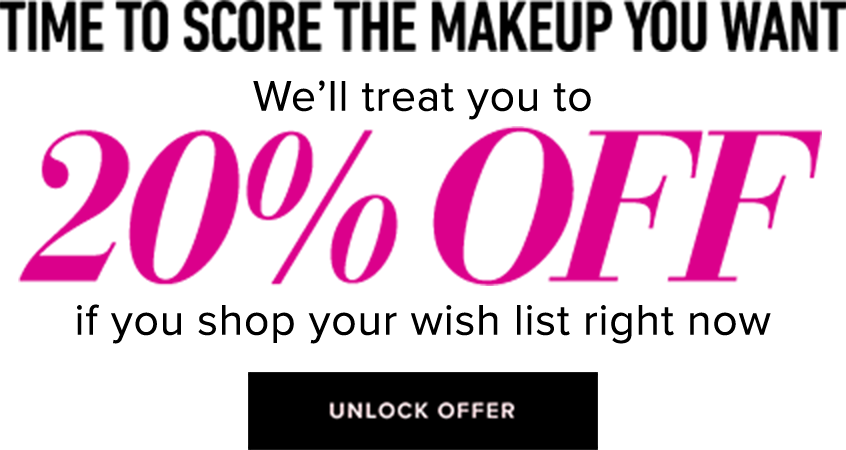 Later in the email, they direct the recipient to customer service if they have any questions and feature their returns policy:
Later in the email, they direct the recipient to customer service if they have any questions and feature their returns policy:
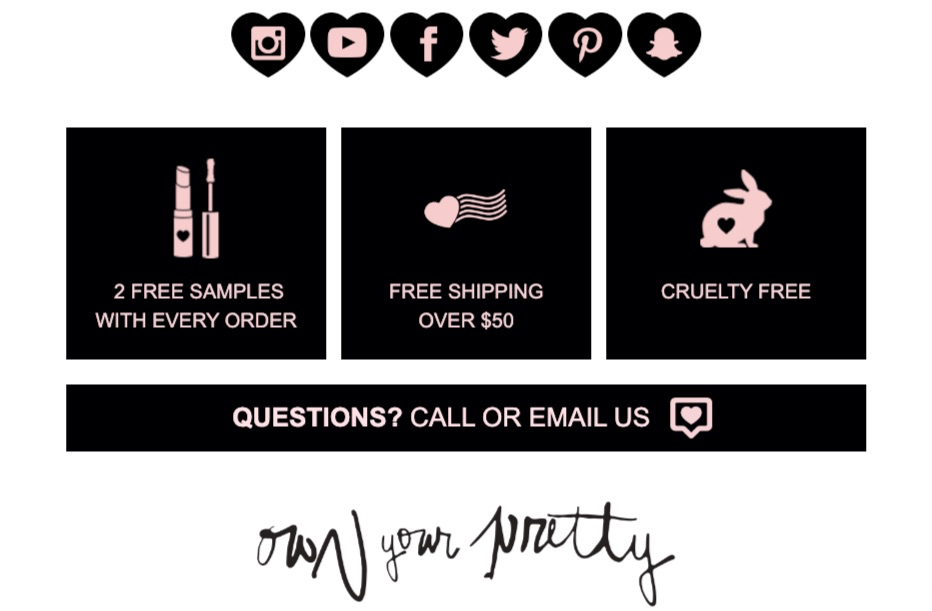 Returns are a major potential roadblock for ecommerce customers. So what Nike does here removes a barrier for customers by offering free, easy returns.
Returns are a major potential roadblock for ecommerce customers. So what Nike does here removes a barrier for customers by offering free, easy returns.
The key is understanding what prevents your audience from making a purchase and providing a solution.
3. Post-First Purchase Series
When a customer has made their first purchase, you’ve gotten over the first hurdle. The next hurdle is to get them to become repeat customers. That’s where the post-first purchase workflow comes in.
Use it to ensure that customers have a positive experience with your brand and that your store remains at the top of their minds. The goal is, of course, to make personalized recommendations to encourage them to return to your store.
Your automated email series may look something like this:
- Email 1. Thank the customer for their order
- Email 2. Share useful information about their order
- Email 3. Recommend related products e.g. cross-sells
- Email 4. Request feedback
Here’s an example of a post-first purchase email in action:
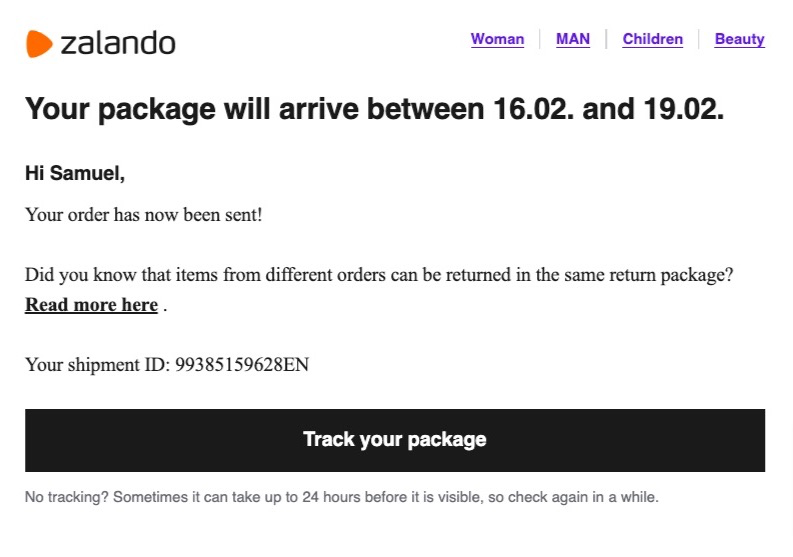 The company, Zalando, shares important shipping information and a link to its shipping FAQs.
The company, Zalando, shares important shipping information and a link to its shipping FAQs.
It’s important to keep customers well-informed in order to create a positive customer experience. If they have all of the information to hand, they’re less likely to experience something unexpected and get frustrated.
In the same email, Moment directs the recipient to content related to their order:
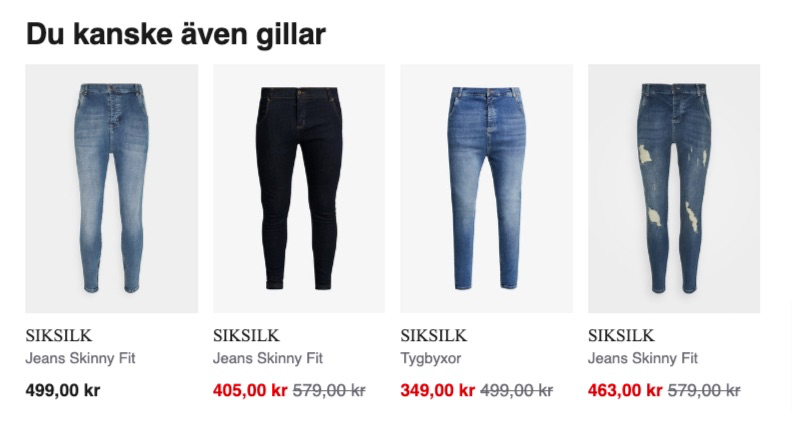 This is personalized, relevant content. It adds value for the customer by helping them get the most out of their purchase. Plus, it shows that the brand appreciates them.
This is personalized, relevant content. It adds value for the customer by helping them get the most out of their purchase. Plus, it shows that the brand appreciates them.
4. Post-Repeat Purchase Series
This series is about building long-term relationships with customers.
Reward them and prove that you appreciate their loyalty. This means they’re less likely to switch brands. What’s more, you can turn repeat customers into advocates that promote your products for you.
For a workflow like this, you may wish to segment customers based on the number of purchases they’ve made. Their second purchase triggers one email, their third purchase triggers another email, and so on. You may end up with something like this:
- Second purchase. Send a discount code
- Third purchase. Invite to a social media community
- Fourth purchase. Share a special reward
- Fifth purchase. Request a referral
In this example, ArtSnacks invite its subscribers to an in-person meetup:
This idea of being part of a club makes users want to stick with a brand.
It’s not such a far-out request. But only if you send it to existing, loyal customers. This kind of thing wouldn’t work in another workflow for customers at a different stage as they may be turned off.
Plus, the brand offers rewards program points in return for social shares. They aren’t asking for somethin’ for nothing.
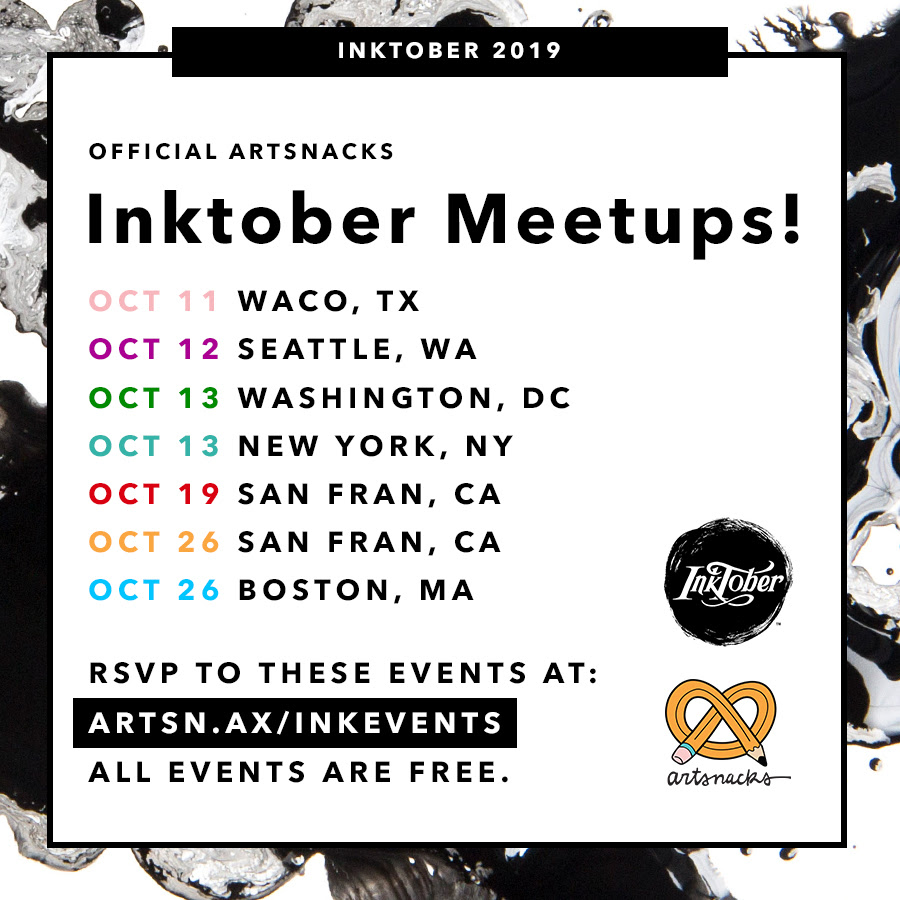
5. Win-Back Email Series
If you don’t see a customer in a while, they’re not necessarily lost. The purpose of the win-back series is to re-engage customers that made a purchase previously but haven’t returned to your store.
The good thing about this kind of campaign is that it’s often easier and cheaper to re-engage previous customers than to acquire new ones. All you have to do is remind them why they bought from you in the first place and offer them an incentive to come back.
So you might send the following emails:
- Email 1. Offer a discount when they make another purchase
- Email 2. Share social proof
- Email 3. Offer another incentive and ask for feedback to learn why they dropped off
Here’s a great example of an incentive email from Birchbox:
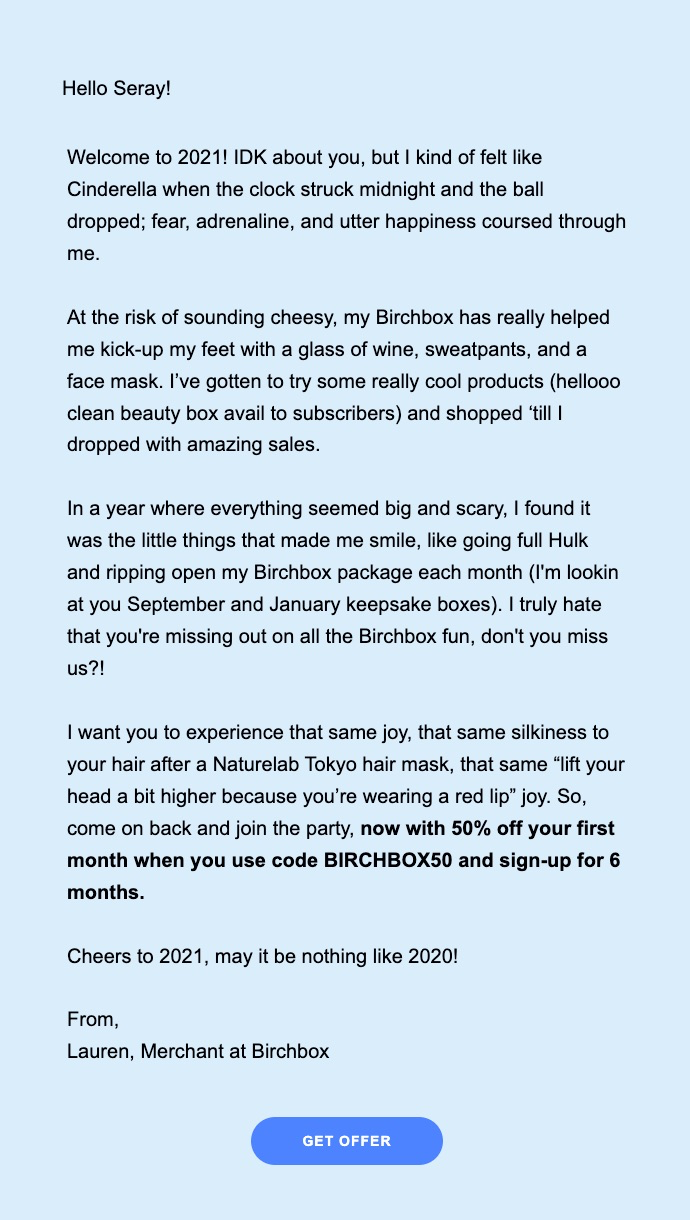 It’s rather a persuasive email and not just because they offer a discount for the customer to come back. The copy is evocative when the company writes things like, “I want you to experience that same joy, the same silkiness to your hair…”
It’s rather a persuasive email and not just because they offer a discount for the customer to come back. The copy is evocative when the company writes things like, “I want you to experience that same joy, the same silkiness to your hair…”
Interestingly enough, they’ve also opted for just copy. There are no big flashing discount signs and so on. This adds to the idea that the company is genuine and doesn’t want to use cheap ploys to get the customer back on board.
How to Create Email Workflows for Your Ecommerce Store
Now you know what kind of emails you need to send as part of an automated email workflow, it’s time to learn how to put these ideas into action:
1. Set a Goal
Before you create a workflow, you need to establish your key objective. This goal is what you want the outcome of your workflow to be. For instance, it could be “Submitted feedback” or “Placed an order.”
Let’s say BigCommerce is my OMS and I want to follow up with potential buyers who abandon their cart at checkout. I could click Drip’s BigCommerce Cart Abandonment workflow and choose a goal in the next step.
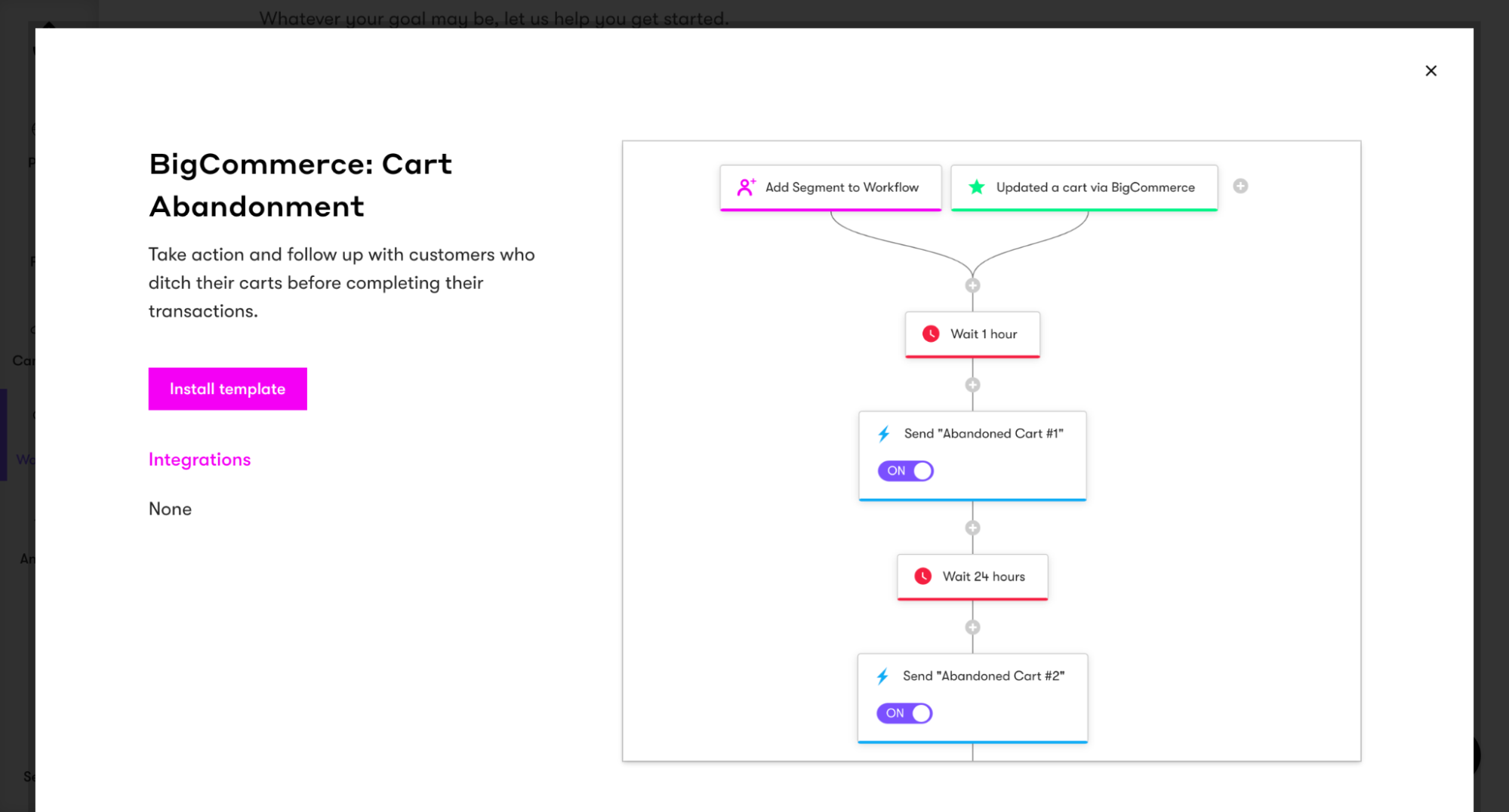
The goal is at the end of a workflow and when a customer achieves it, they’ll exit the workflow. This is because you don’t want them to receive further emails in the series when they’ve already completed an action. It would be a poor customer experience.
2. Establish a Trigger
A trigger is an event that places a customer in the workflow. While the goal is at the end of the sequence, the trigger, naturally, comes at the beginning.
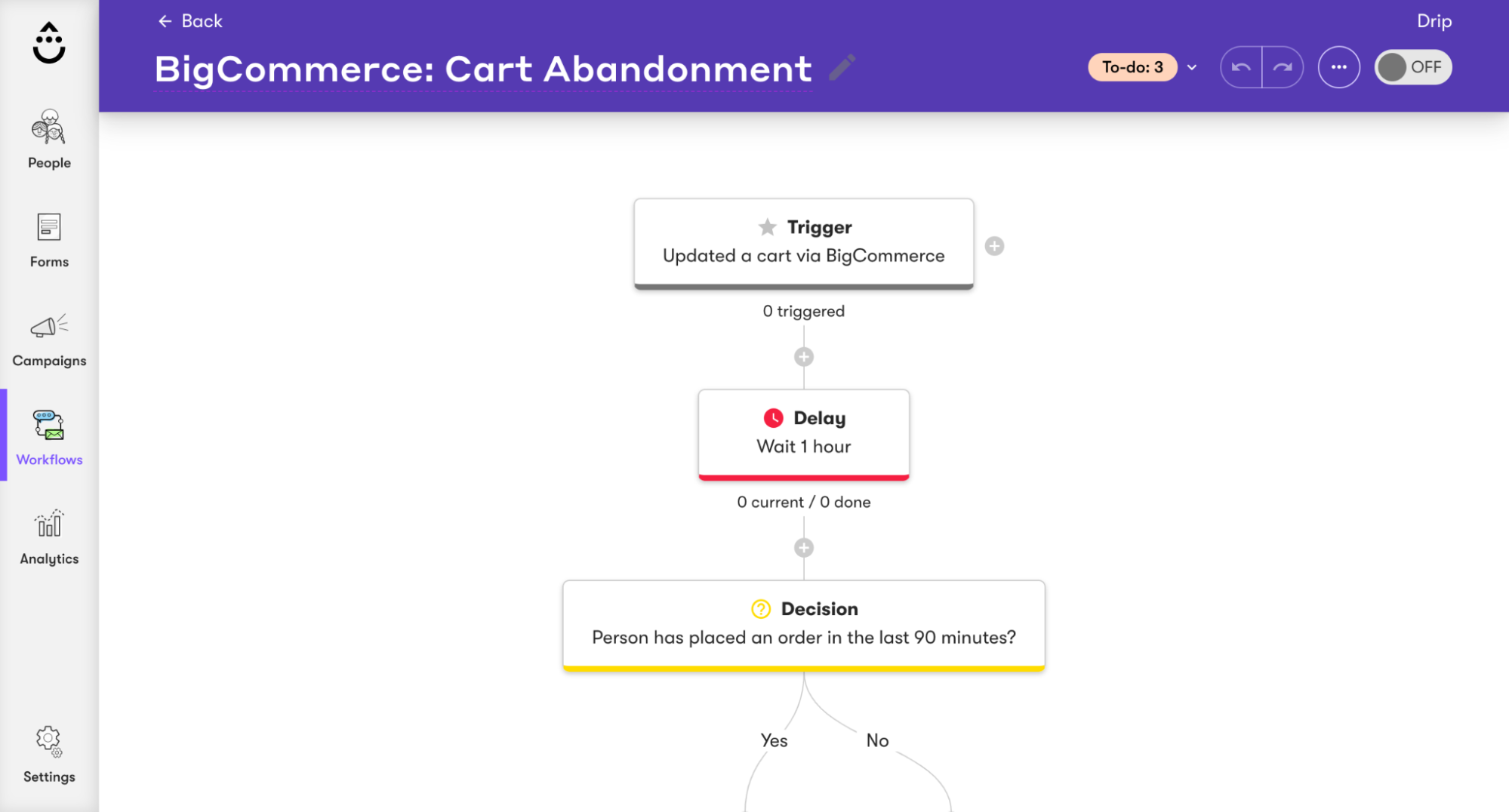 For a cart abandonment sequence, the trigger would be “updated a cart”, for a welcome series, “new subscribe”, and so on.
For a cart abandonment sequence, the trigger would be “updated a cart”, for a welcome series, “new subscribe”, and so on.
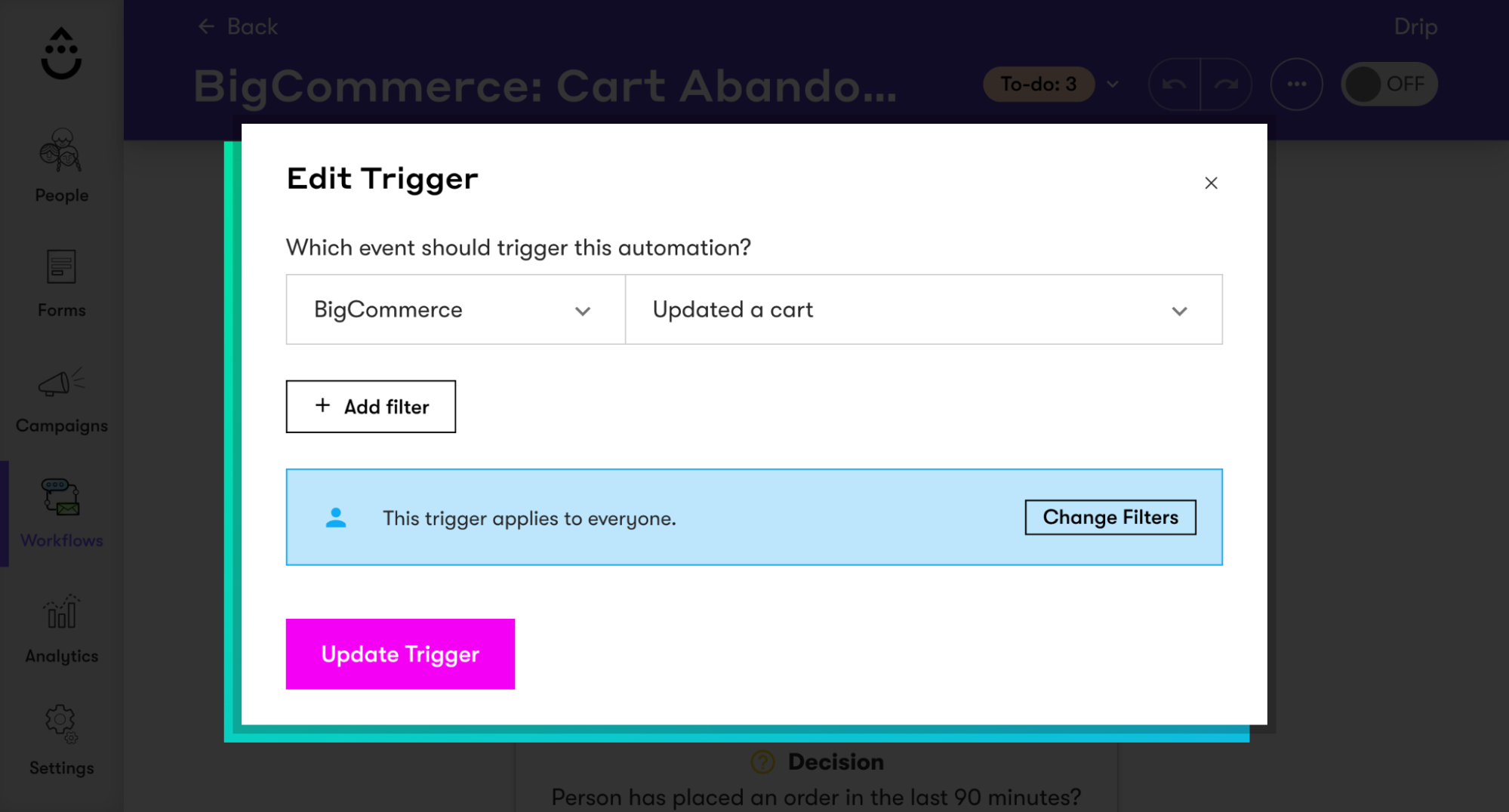
You may also wish to add further criteria to a trigger event that users must meet in order to enter the workflow. As you can see here, for instance, the person must have placed an order at least once this month to enter the workflow:
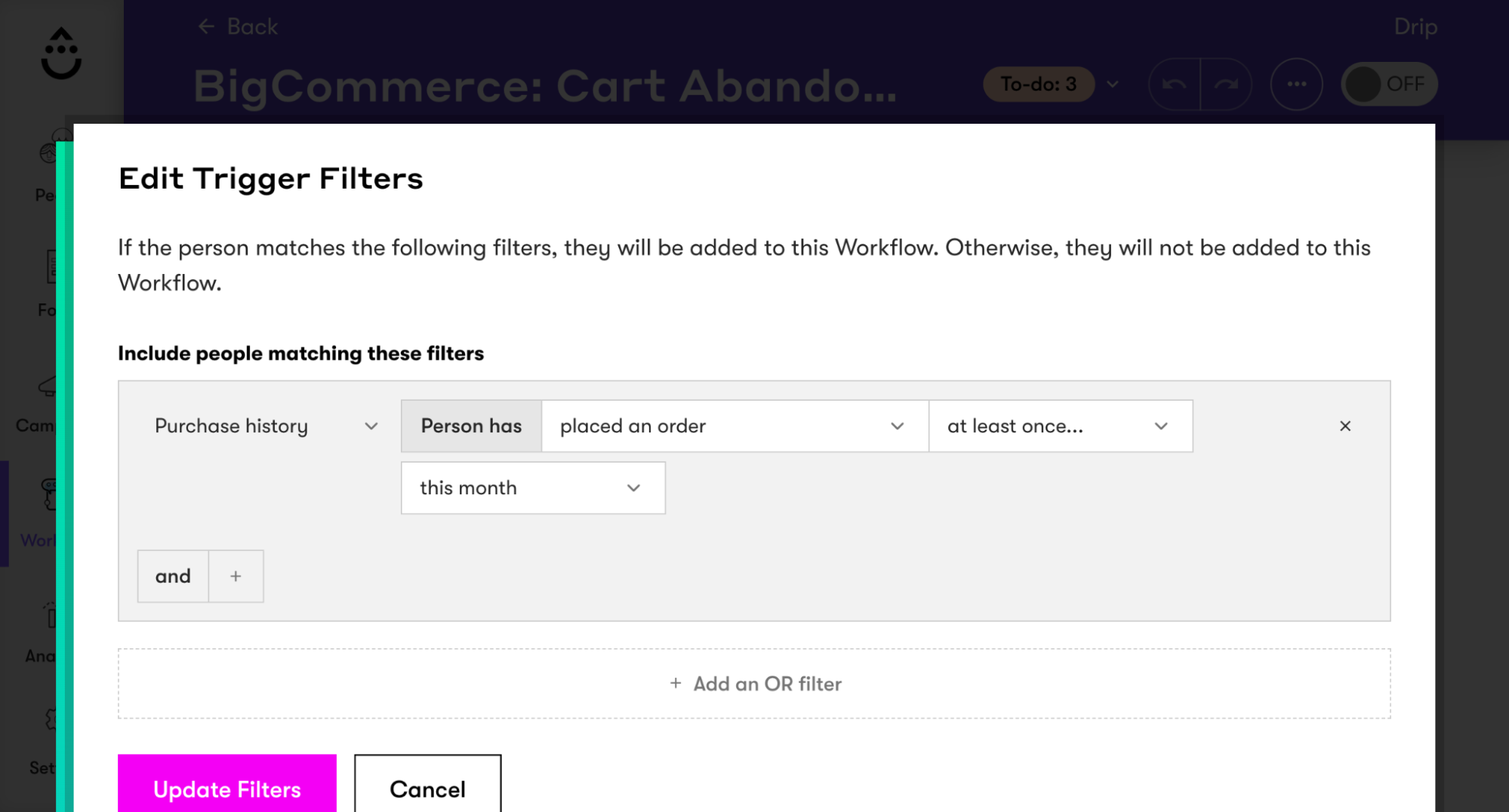 This is useful as it allows you to be even more personalized with your campaigns.
This is useful as it allows you to be even more personalized with your campaigns.
3. Create Email Content
At this point you’ll need to create the emails you’ll send to the customer as part of the workflow. Depending on your software provider you may need to upload these assets to the automation platform.
With Drip, you can design emails directly within the platform. Simply click on the email box in your workflow and select Edit email.
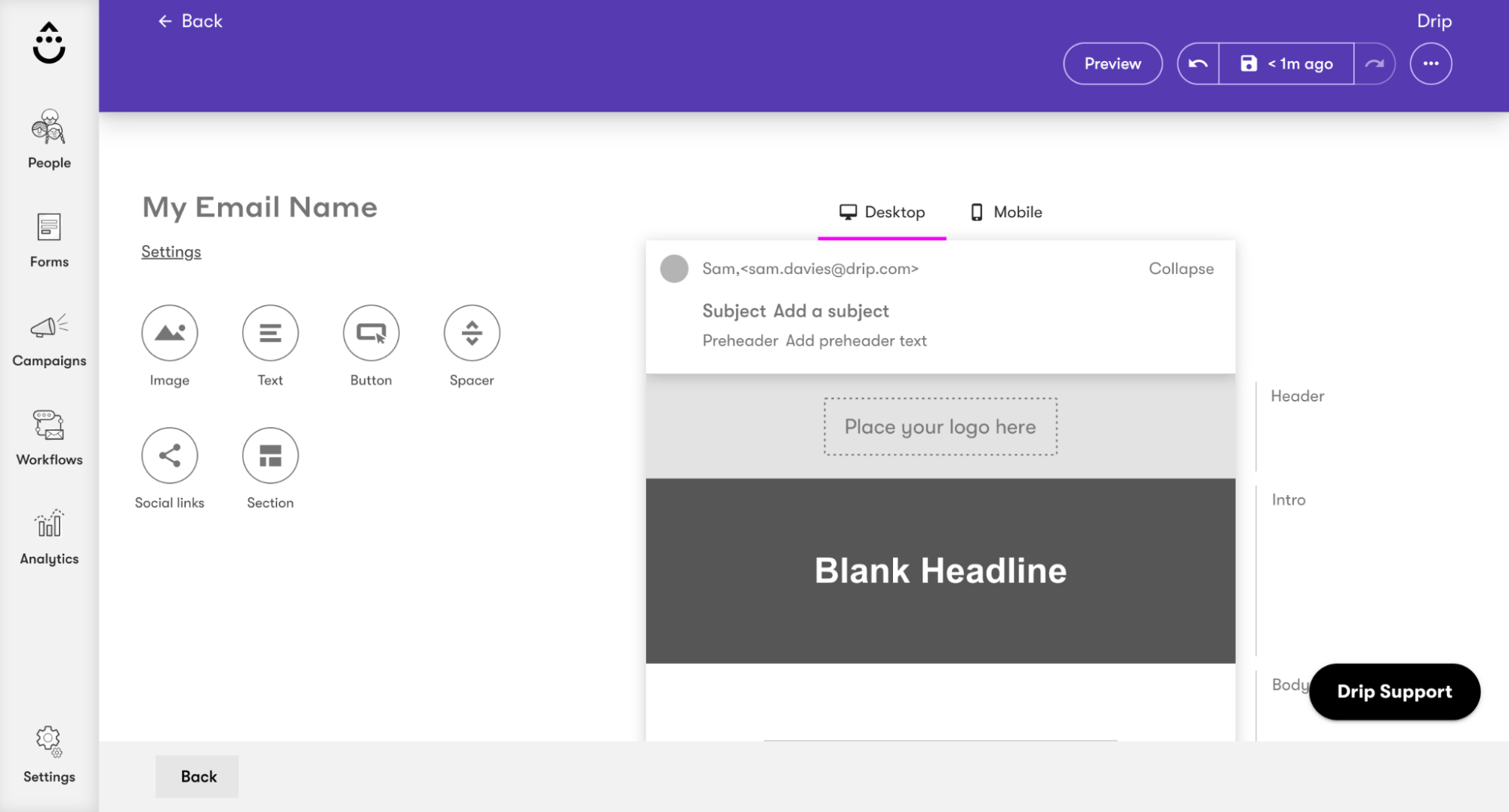
There is a range of templates available that’ll help you with the layout of your email. Plus, each template contains handy guidance for the type of email that you’re sending. If you want to add more sections simply use the drag and drop builder.
4. Utilize Workflow Components
Workflows need a series of components to operate. These are the building blocks that make up your automated sequence, telling it what to do with a customer.
You’ve already seen triggers and goals. Further components include:
i. Actions. Carries out an action related to the user, such as adding them to a list, flagging them as a prospect, or syncing their data with your CRM.
ii. Decisions. Depending on what decision the consumer makes they'll be taken down a particular branch of the workflow. In this example, the customer exits the workflow when they place an order OR is sent an email if they don’t place an order:
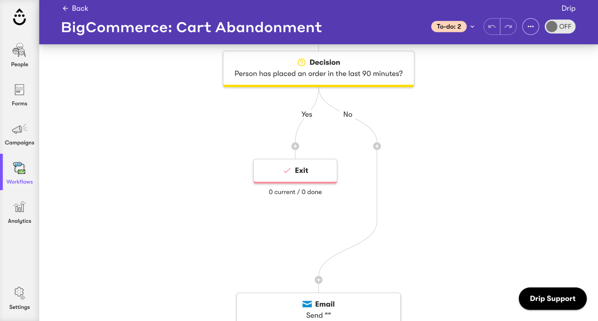
iii. Delays. Sets a time delay between different steps in the workflow. For instance, you may want to hold a customer for 24 hours before sending a second email.
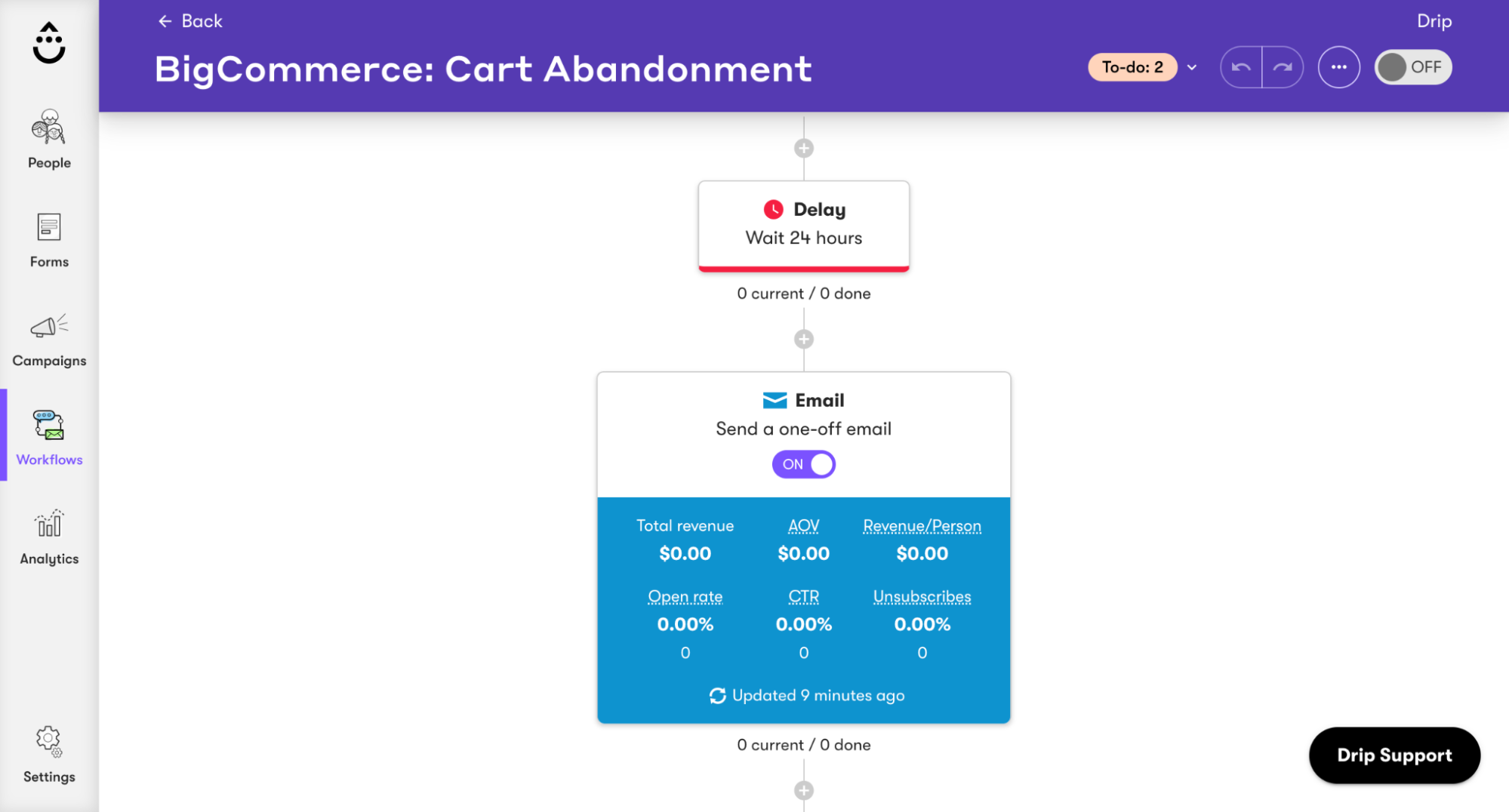
5. Track Campaign Results
The final step is to monitor how your workflows perform. This way you can make changes to optimize them where necessary.
Within the Analytics section of the Drip dashboard, for instance, you can see reports in real-time. These display need-to-know metrics for your campaigns, such as clicks, revenue, time to purchase, and more.

Final Word
Email workflows allow you to send personalized emails to tons of consumers. And as automated emails are so relevant to the user, they drive action. Implementing automated workflows for your ecommerce store is, therefore, a no-brainer.
To do it successfully, you need to carefully formulate your workflows. Use your understanding of customer behaviors to optimize these workflows and create awesome email content.
What’s next? Build your first email workflow—possibly a welcome series to get the ball rolling.

